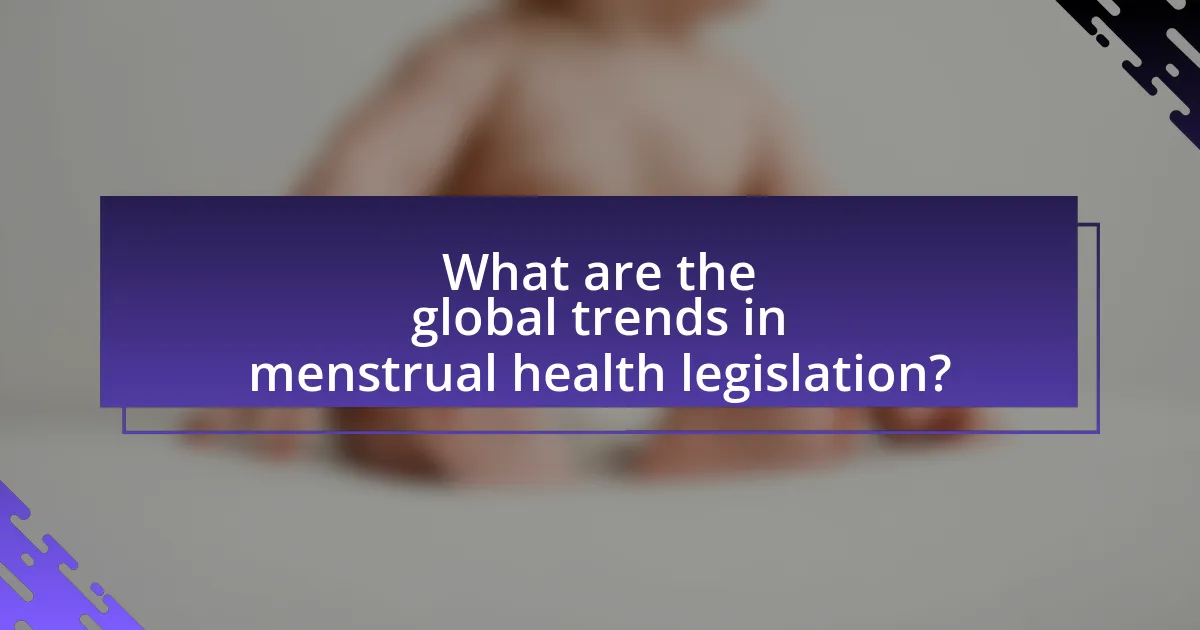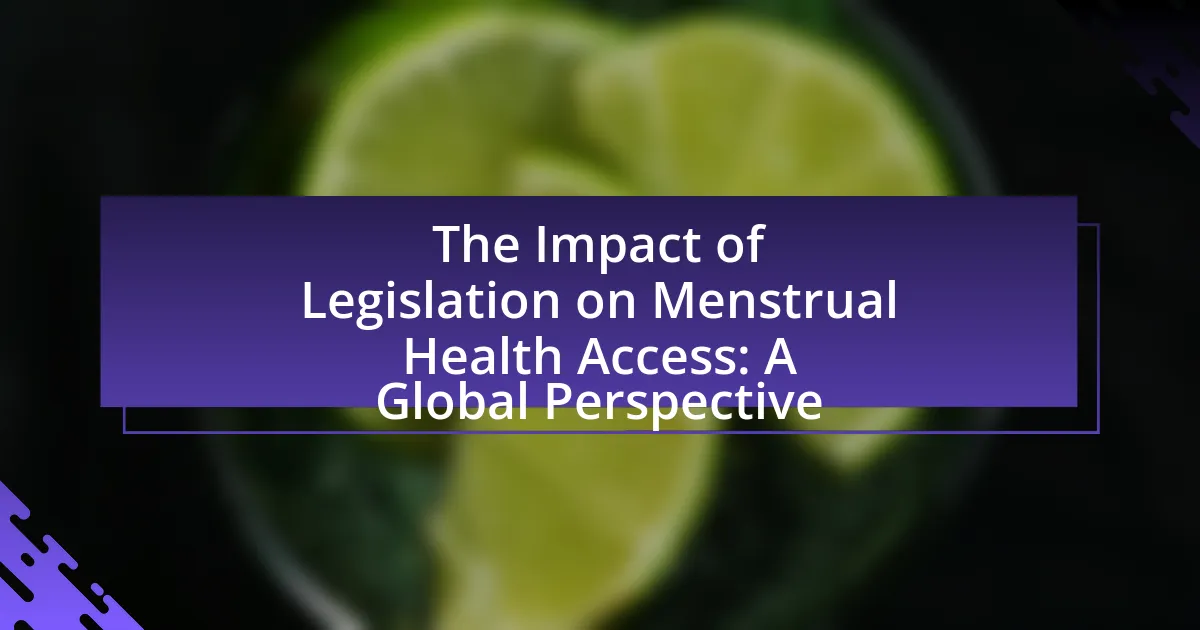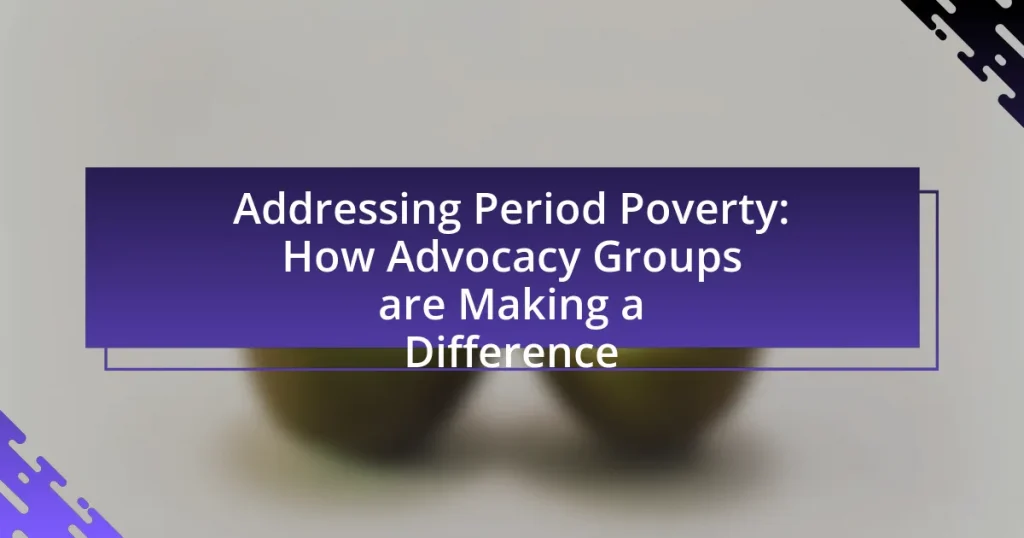The article examines the impact of legislation on menstrual health access from a global perspective, highlighting how legal frameworks influence the availability, affordability, and education surrounding menstrual products and services. It discusses successful legislative measures in various countries, such as Scotland, Kenya, and India, which have improved access and reduced stigma associated with menstruation. Key components of effective menstrual health legislation include access to products, education, and hygienic facilities, while the article also addresses the challenges faced in implementing such laws, including cultural attitudes and socioeconomic factors. Additionally, it emphasizes the importance of international organizations and community engagement in promoting menstrual health initiatives and improving overall health outcomes and gender equality.

What is the Impact of Legislation on Menstrual Health Access?
Legislation significantly impacts menstrual health access by establishing frameworks that ensure availability, affordability, and education regarding menstrual products and services. For instance, countries like Scotland have implemented policies to provide free menstrual products in schools and public facilities, which has increased accessibility for individuals in need. Research indicates that such legislative measures can reduce stigma and improve overall menstrual health outcomes, as evidenced by a study published in the Journal of Public Health, which found that access to free menstrual products led to a 30% increase in usage among low-income populations. Thus, effective legislation directly correlates with enhanced menstrual health access and equity.
How does legislation influence menstrual health access globally?
Legislation significantly influences menstrual health access globally by establishing legal frameworks that ensure the availability and affordability of menstrual products and services. For instance, countries like Kenya and India have enacted laws to eliminate taxes on menstrual products, thereby reducing financial barriers for individuals in need. Additionally, comprehensive menstrual health policies can mandate education and awareness programs, which are crucial for destigmatizing menstruation and promoting informed health choices. Research indicates that in regions where supportive legislation exists, such as in parts of Europe, there is a marked increase in access to menstrual health resources, leading to improved health outcomes and gender equality.
What are the key components of menstrual health legislation?
Key components of menstrual health legislation include access to menstrual products, education on menstrual health, and the provision of safe and hygienic facilities for menstrual management. Access to menstrual products ensures that individuals can obtain necessary supplies without financial barriers, which is crucial for maintaining health and dignity. Education on menstrual health promotes awareness and reduces stigma, enabling informed choices and fostering a supportive environment. Safe and hygienic facilities, such as clean restrooms and disposal options, are essential for managing menstruation effectively, particularly in schools and workplaces. These components collectively contribute to improved menstrual health outcomes and gender equality.
How do different countries approach menstrual health legislation?
Different countries approach menstrual health legislation with varying degrees of support and regulation. For instance, in Canada, menstrual products are exempt from sales tax, reflecting a commitment to menstrual equity, while in India, the government has implemented schemes to provide free sanitary products to schoolgirls, aiming to improve access and reduce stigma. In contrast, some countries lack comprehensive legislation, resulting in limited access to menstrual health resources. The World Health Organization emphasizes that effective menstrual health policies can significantly improve health outcomes and gender equality, highlighting the importance of legislative frameworks in addressing menstrual health globally.
Why is menstrual health access important for individuals and communities?
Menstrual health access is crucial for individuals and communities because it directly affects physical health, educational opportunities, and economic productivity. When individuals have access to menstrual health resources, such as sanitary products and education, they experience fewer health complications, which can lead to improved overall well-being. For instance, a study by the World Bank found that inadequate menstrual health management can lead to school absenteeism, with girls missing up to 20% of school days due to menstruation. This absence negatively impacts their education and future economic prospects. Furthermore, communities benefit from menstrual health access as it promotes gender equality and empowers women, contributing to social and economic development. Access to menstrual health resources fosters an environment where individuals can participate fully in society, thereby enhancing community resilience and cohesion.
What are the health implications of inadequate menstrual health access?
Inadequate menstrual health access leads to significant health implications, including increased risk of reproductive health issues, mental health disorders, and social stigmatization. Women and girls lacking access to menstrual hygiene products and education are more likely to experience infections, such as urinary tract infections and reproductive tract infections, due to the use of unhygienic materials. Furthermore, studies indicate that inadequate menstrual health management can contribute to anxiety and depression, as the inability to manage menstruation can lead to feelings of shame and isolation. According to a report by the World Health Organization, approximately 500 million women and girls worldwide lack adequate facilities for menstrual hygiene management, exacerbating these health risks and highlighting the urgent need for improved access and education.
How does menstrual health access affect gender equality?
Menstrual health access significantly affects gender equality by enabling individuals who menstruate to participate fully in education, employment, and social activities. When menstrual health services and products are accessible, it reduces absenteeism in schools and workplaces, thereby promoting equal opportunities. For instance, a study by the World Bank found that lack of access to menstrual hygiene products can lead to girls missing up to 20% of school days, which directly impacts their educational attainment and future economic prospects. Furthermore, improved menstrual health access contributes to breaking down stigmas associated with menstruation, fostering a more inclusive society where gender equality can thrive.

What are the global trends in menstrual health legislation?
Global trends in menstrual health legislation indicate a growing recognition of menstrual health as a critical aspect of public health and gender equality. Countries are increasingly implementing policies that promote access to menstrual products, education, and hygiene facilities. For instance, in 2020, Scotland became the first country to provide free menstrual products to all, reflecting a shift towards addressing period poverty. Additionally, various nations are revising tax policies to eliminate taxes on menstrual products, recognizing them as essential goods. The World Health Organization emphasizes the importance of menstrual health in achieving gender equity, further driving legislative changes worldwide.
How have recent legislative changes impacted menstrual health access?
Recent legislative changes have significantly improved menstrual health access by mandating the provision of menstrual products in schools and public facilities. For instance, countries like Scotland have implemented laws requiring free access to menstrual products, which has increased availability and reduced stigma associated with menstruation. Additionally, various states in the U.S. have passed legislation to eliminate taxes on menstrual products, making them more affordable. These changes are supported by research indicating that access to menstrual products is crucial for maintaining health and educational outcomes, particularly for low-income individuals.
What countries have made significant progress in menstrual health legislation?
Countries that have made significant progress in menstrual health legislation include India, Kenya, and Canada. India has implemented the Menstrual Hygiene Management (MHM) policy, which aims to improve access to menstrual products and education. Kenya has passed the Menstrual Health Management Bill, ensuring free access to menstrual products in schools. Canada has taken steps to eliminate the Goods and Services Tax on menstrual products, recognizing them as essential items. These legislative measures reflect a growing recognition of menstrual health as a critical aspect of public health and gender equality.
What challenges do countries face in implementing menstrual health legislation?
Countries face several challenges in implementing menstrual health legislation, including cultural stigma, lack of funding, and insufficient data. Cultural stigma surrounding menstruation often leads to societal resistance against discussing and addressing menstrual health openly, which hinders legislative efforts. Additionally, many governments struggle to allocate adequate funding for menstrual health initiatives, limiting the resources available for education, product distribution, and healthcare services. Furthermore, the absence of comprehensive data on menstrual health needs and practices complicates the development of effective policies, as lawmakers may lack the necessary evidence to support their initiatives. These factors collectively impede the successful implementation of menstrual health legislation across various nations.
What role do international organizations play in shaping menstrual health legislation?
International organizations play a crucial role in shaping menstrual health legislation by providing guidelines, funding, and advocacy to promote policies that ensure access to menstrual health services. For instance, the World Health Organization (WHO) and United Nations Population Fund (UNFPA) have developed frameworks that encourage countries to integrate menstrual health into their health policies, emphasizing the importance of education, hygiene, and access to products. These organizations also conduct research and disseminate data that highlight the health and social implications of inadequate menstrual health management, influencing national governments to adopt more comprehensive legislation.
How do global initiatives influence national policies on menstrual health?
Global initiatives significantly influence national policies on menstrual health by providing frameworks, funding, and advocacy that encourage governments to prioritize menstrual health in their health agendas. For instance, the United Nations’ Sustainable Development Goals (SDGs) emphasize gender equality and health, prompting countries to adopt policies that address menstrual health as part of broader health and education reforms. Additionally, organizations like the World Health Organization (WHO) and various NGOs offer guidelines and resources that help shape national policies, ensuring they align with international standards and best practices. Evidence of this influence can be seen in countries like Kenya, where the introduction of free sanitary products in schools was driven by global advocacy efforts, demonstrating a direct link between international initiatives and national policy changes.
What partnerships exist to promote menstrual health access worldwide?
Partnerships that promote menstrual health access worldwide include the Global Menstrual Health Coalition, which unites organizations like WaterAid, Plan International, and the United Nations Population Fund (UNFPA) to advocate for policy changes and improve access to menstrual products. Additionally, the Menstrual Health Hub collaborates with various stakeholders to share resources and best practices, while initiatives like the Menstrual Hygiene Management (MHM) in Schools program focus on integrating menstrual health education into school curricula. These partnerships are essential for addressing the stigma and barriers surrounding menstrual health, as evidenced by the increasing recognition of menstrual health as a critical component of gender equality and public health.

What are the specific barriers to menstrual health access created by legislation?
Specific barriers to menstrual health access created by legislation include restrictions on the distribution and affordability of menstrual products, lack of comprehensive education on menstrual health, and inadequate healthcare policies that fail to address menstrual-related issues. For instance, some countries impose taxes on menstrual products, making them less affordable for low-income individuals, while others lack laws mandating the provision of menstrual products in schools and public facilities. Additionally, legislation may not require comprehensive menstrual health education in school curricula, leading to misinformation and stigma surrounding menstruation. These legislative gaps contribute to significant challenges in accessing necessary menstrual health resources and support.
How do cultural attitudes affect the implementation of menstrual health laws?
Cultural attitudes significantly influence the implementation of menstrual health laws by shaping societal norms and perceptions surrounding menstruation. In many cultures, menstruation is stigmatized, leading to a lack of support for policies aimed at improving menstrual health. For instance, in countries where menstruation is viewed as a taboo subject, lawmakers may face resistance from communities when attempting to introduce comprehensive menstrual health legislation. This resistance can manifest in inadequate funding, limited public awareness campaigns, and insufficient educational resources, ultimately hindering the effectiveness of such laws. Research indicates that in regions with strong cultural taboos, like parts of South Asia, the lack of open dialogue about menstruation directly correlates with poor menstrual health outcomes and limited access to necessary products and services.
What misconceptions exist regarding menstrual health that hinder access?
Misconceptions regarding menstrual health that hinder access include the belief that menstruation is a taboo subject, leading to silence and stigma around discussing it. This stigma can prevent individuals from seeking necessary medical care or education about menstrual health. Additionally, the misconception that menstrual products are a luxury rather than a necessity contributes to inadequate access, particularly in low-income communities. According to a study published in the journal “BMC Women’s Health,” 1 in 10 girls in Africa misses school during their menstrual cycle due to a lack of access to sanitary products, highlighting the real-world impact of these misconceptions. Furthermore, the belief that menstrual pain is normal and should be endured can discourage individuals from seeking treatment for underlying health issues, such as endometriosis, which affects approximately 10% of reproductive-age women globally.
How do socioeconomic factors influence menstrual health access?
Socioeconomic factors significantly influence menstrual health access by determining the availability of resources, education, and healthcare services. Individuals from lower socioeconomic backgrounds often face barriers such as limited financial means to purchase menstrual products, lack of access to healthcare facilities, and insufficient education about menstrual health. For instance, a study published in the Journal of Global Health found that women in low-income areas are 1.5 times more likely to experience inadequate menstrual health management compared to those in higher-income brackets. This disparity highlights how socioeconomic status directly impacts the ability to access necessary menstrual health resources and education, ultimately affecting overall health outcomes.
What best practices can improve menstrual health access through legislation?
Implementing comprehensive menstrual health legislation can significantly improve access to menstrual products and education. Best practices include mandating the provision of free menstrual products in schools and public facilities, which has been shown to increase attendance and participation among menstruators. For instance, Scotland became the first country to provide free menstrual products, resulting in a reported 95% increase in access among students. Additionally, integrating menstrual health education into school curricula promotes awareness and reduces stigma, as evidenced by programs in countries like Kenya, where education initiatives have led to improved understanding and management of menstrual health. Furthermore, ensuring that menstrual products are classified as essential goods can reduce taxes and improve affordability, as seen in various U.S. states that have eliminated the “tampon tax.” These legislative measures collectively enhance access to menstrual health resources and support overall public health.
How can policymakers effectively engage communities in menstrual health initiatives?
Policymakers can effectively engage communities in menstrual health initiatives by fostering inclusive dialogue and collaboration with local stakeholders. This approach ensures that the initiatives are culturally relevant and address the specific needs of the community. For instance, involving community leaders, healthcare providers, and women’s groups in the planning and implementation phases can enhance trust and participation. Research indicates that community-driven programs, such as those highlighted in the “Menstrual Health Management in Schools” report by the United Nations Children’s Fund (UNICEF), demonstrate improved outcomes when local voices are prioritized. Engaging communities through workshops, surveys, and focus groups allows policymakers to gather valuable insights and tailor interventions accordingly, ultimately leading to more effective menstrual health initiatives.
What successful case studies exist for improving menstrual health access?
Successful case studies for improving menstrual health access include the Menstrual Hygiene Management (MHM) program in Kenya, which has significantly increased access to sanitary products and education in schools. This initiative, supported by the Kenyan government and NGOs, has led to a reported 30% increase in school attendance among girls during menstruation. Another example is India’s Menstrual Health and Hygiene Management (MHHM) initiative, which has distributed over 100 million sanitary napkins through government programs, improving access in rural areas and reducing stigma. These case studies demonstrate effective strategies in enhancing menstrual health access through targeted programs and legislative support.
What practical steps can individuals take to advocate for better menstrual health access?
Individuals can advocate for better menstrual health access by engaging in community education and awareness campaigns. By organizing workshops and discussions, individuals can inform others about menstrual health issues, thereby reducing stigma and promoting understanding. Research indicates that education significantly improves menstrual health outcomes, as seen in programs implemented in various countries that have led to increased awareness and access to menstrual products. Additionally, individuals can support policy changes by contacting local representatives to advocate for legislation that ensures access to menstrual products in schools and public facilities. Studies show that countries with supportive policies see improved health outcomes and reduced absenteeism among menstruators. Furthermore, individuals can collaborate with organizations focused on menstrual health to amplify their efforts and reach a broader audience, as partnerships often enhance the effectiveness of advocacy initiatives.



